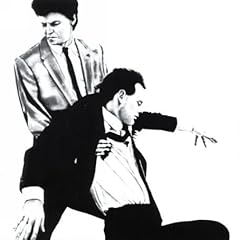
"Glenn Branca (born October 6, 1948 in Harrisburg, Pennsylvania) is a highly-influential avant-garde composer and guitarist known for his use of volume, alternate tuned guitars, repetition, droning, and the harmonic series.
Glenn Branca's compositions center around multiple guitars — four or more, heavily amplified — augmented by a rock-based rhythm section of drums and bass. In later works, the composer began adding other instruments, including mallet guitar, keyboards, and occasionally a second drummer. Branca's minimalist compositions frequently require unusual guitar tunings — more recent works have them strung with two sets of three strings tuned an octave apart. Many of downtown New York City's more notable experimental guitarists have been a part of his ensemble, including Thurston Moore and Lee Ranaldo of the punk rock band Sonic Youth. Branca studied performing arts at Emerson College in Boston."
AMG: "If one chooses to categorize the music on this recording as "rock," this is surely one of the greatest rock albums ever made. But there's the rub. While sporting many of the trappings of the genre — the instrumentation (electric guitars), the rhythms, the volume, and, most certainly, the attitude — there is much about The Ascension that doesn't fit comfortably into the standard definition of the term. Not only does the structure of the compositions appear to owe more to certain classical traditions, including Romanticism, than the rock song form, but Branca's overarching concern is with the pure sound produced, particularly of the overtones created by massed, "out of tune," excited strings and the ecstatic quality that sound can engender in the listener. Though his prior performing experience was with post-punk, no-wave groups like the Static and Theoretical Girls, it could be argued that the true source of much of the music here lies in the sonic experimentation of deep-drone pioneers like La Monte Young and Phil Niblock. Happily, the music is accessible enough that one can jump right in, regardless of one's direction of approach. Branca's band, unlike some of his later enormous ensembles, is relatively modest (four guitars, bass guitar, and drums), so the sound is comparatively clear and each member's contributions may be easily discerned. The chiming notes that begin "The Spectacular Commodity" are allowed to hover in the air, awash in overtones, before being subsumed into a rolling groove that picks up more and more intensity as guitar chords cascade one atop another, threatening to, but never succeeding in, toppling the whole affair. "Structure" plays with sonic torque, whipsawing between two differently stressed voicings of the same theme, pulling them back and forth like taffy. But the title track is both the consummation of the record and the surest indication of Branca's direction in later years. It begins with a marvelously dense haze of ringing guitars, feedback, and percussion, with a foreboding bassline contributing to the strong sense of disorientation. Midway through, it abruptly shifts to harsh blocks of sound over a rapid rhythm, the blocks differing in texture but played in alternating sections, smacking into each other and further heightening the tension. These disparate sounds eventually coalesce into a pure, ringing tone that, over the last minute of the piece, explodes into a spectacular cacophony, a seism of bell tones, microtonal eruptions, and near orgasmic guitar bliss. An absolutely stunning, jaw-dropping performance. Branca's music has served as a major inspiration to many alternative rock bands that surfaced in the '80s and '90s, notably Sonic Youth; both Lee Ranaldo (who plays on this recording) and Thurston Moore were regularly members of his early ensembles. The Ascension, in addition to being an utterly superb album on its own merits, uniquely invites listening from both adventurous rock fans and aficionados of experimental electronic music. For years, the vinyl release on 99 Records, with its stunning cover illustration by Robert Longo, was a highly sought-after collector's item. It was finally issued to compact disc in 1999 by New Tone." 4.5/5
Download: http://www.mediafire.com/?feitgwkhcbm
Sounds like... Terry Riley, Luc Ferrari
Tags: Experimental, Avant-garde, No Wave, Contemporary Classical
3 comments:
Great blog!!
Out-there is just a mirror. And I love math rock. :)
Thanks. That makes two of us. Lots of math rock on my computer just waiting to be uploaded. :)
Post a Comment